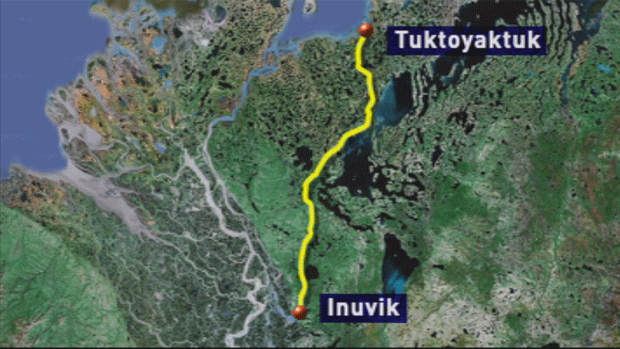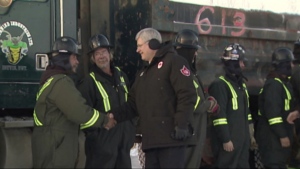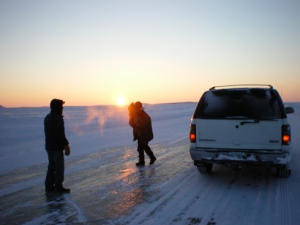Blog: Oil companies real beneficiaries of Canada’s Arctic highway extension

On January 8, in Inuvik, Northwest Territories, Canadian Prime Minister Stephen Harper presided over the groundbreaking ceremony of the extension of the Dempster Highway to Tuktoyaktuk, on the Arctic Ocean’s coastline.
The extension will lengthen the highway 137 kilometers, finally bringing an all-weather road to Tuk. The existing road, which opened in 1979, stretches 730 kilometers from Dawson City, Yukon to Inuvik, crossing the Arctic Circle and several rivers in the process. Ferries allow vehicles to travel across the Peel and Mackenzie Rivers in the summer, when they are not frozen.
The extension of the project will cost an estimated $299 million, with the federal government paying 2/3 of costs. The Government of the Northwest Territories will pick up the remaining third, though there are some concerns that due to potential cost overruns, they will have to pay for a larger amount than anticipated. Road construction will employ an estimated 150 people annually, bringing new jobs to the region. Construction is slated to finish in 2017 or 2018.
Harper, no stranger to Canada’s North thanks to his annual summertime trips to the region, unsurprisingly took the opportunity to travel to Inuvik to mark the start of road construction. Hearkening back to a former leader of

Canada who was also a champion of big, state-sponsored projects in the Arctic, Harper announced, “I am tremendously proud that our Government’s investment in this job creating, all-season Inuvik to Tuktoyaktuk highway will, for the first time by road, connect and unify Canada from sea to sea to sea. This historic project realizes the visionary initiative of Canadian Prime Minister John Diefenbaker back in the 1960’s.” In 1958, Diefenbaker articulated his vision for the north in his speech, “A New Vision.” He proclaimed that compared to previous expansion across Canada from east to west, he saw “a new Canada – a Canada of the North.” Specific to roads, Diefenbaker stated, “We will aid in projects which, while not self-liquidating will lead to the development of the national resources for the opening of Canada’s northland. We will open that northland for development by improving transportation and communication and by the development of power, by the building of access roads.”
Local benefits
Fast forward over half a century, and despite increased awareness of the people living alongside resources in the Arctic, the development of commodities is still the real impetus for bringing infrastructure to the north. As the Globe and Mail explains, the all-weather, 24/7 highway will be “an engineering feat that should reduce the costs of petroleum exploration in the Beaufort Sea.” The highway has long been nicknamed the “road to resources.” To be fair, the ~930 people living in Tuktoyaktuk will probably enjoy a lower cost of living once the road is complete, as it will be easier to truck supplies in and out. During some parts of the year, the community is only accessible by ice road, barge, or air. A study (PDF) by the Northwest Territories’ Department of Transportation found that the cost of living savings would reach $1 million for people in Tuktoyaktuk, and about $1.5 million including savings on Food Mail. Other local residents and organizations, such as the Inuvialuit Settlement Region, will also profit from benefits as royalty payments on the gravel laid down for the all-weather road. Yet when you do the math, these amounts of money do not really justify the federal and territorial governments spending $300 million to ostensibly better connect a community in the north to the to the rest of Canada and “improve the lives of people living in the North for generations to come,” as Harper claims.
Big oil benefits
The $300 million in spending, however, does make sense in light of Harper’s strategy to cement Canada’s status as an “emerging energy superpower,” as he stated in 2006. The real beneficiaries of highway to Tuk will be the oil companies. They will save much more than the $1 million saved by the hamlet’s residents. Bob Ball, BP Operations Manager, North American Arctic Exploration, estimated that the all-weather road could reduce the company’s total cost of operations in the Beaufort Sea by 15%, as the road will facilitate overland transport during the current shoulder seasons of spring and fall. The 2010 study by the NWT Department of Transportation also looked specifically at how the road would benefit the Mackenzie Valley Pipeline. Though the project is currently on hold, road construction would have delivered $20-30 million in total increased revenue to the federal government. The oil companies, in contrast, would have received some $347 to $516 million in additional cash flows over 45 years – a disproportionately large benefit.

It’s no coincidence that the road is being built now. As in the 1970s, when oil development in nearby Alaska’s Prudhoe Bay spurred Canada to take action and built its own road up north, oil development is also spurring this round of road construction. Harper is not spending $300 million to assist 930 Northerners. He is mostly spending it to enhance Canada’s status as an energy exporter. In 2010, Imperial Oil, ExxonMobil Canada, and BP entered into a joint venture agreement on multi-year exploration licenses spanning over 1 million acres in the Beaufort Sea. In 2012, an additional six offshore exploration licenses were issued in the Beaufort Sea to Franklin Petroleum. And in 2013, Imperial Oil announced that it was seeking regulatory approval to begin exploratory drilling, potentially as soon as 2020. If the estimates are correct, two of these licenses could be worth some US $1.71 billion. These offshore licenses also lie within federal territory, meaning that local and or indigenous peoples will not draw royalties from their production. Local people in Tuktoyaktuk thus might benefit from the road and from the increased economic activity it permits. But the real beneficiaries of the $300 million in government spending on the all-weather highway will be the oil companies themselves, which won’t have contributed a single penny to the project. Bob Ball, the BP Operations Manager, expressed, “There is a need for a Port connected to an AWR road link for a number of reasons including: i) if BP goes into development and production it will need a vastly improved connected harbour than currently exists at Tuktoyuktuk to support the level of activity that will occur and the type of vessels that will be frequenting the Beaufort Sea ii) National sovereignty and security.”
Indeed, the road is key to Harper’s plan to bolster northern sovereignty. As the press release issued by the Prime Minister’s office reminds, “The initiative is in keeping with two key objectives of Canada’s Northern Strategy: ‘Promoting Social and Economic Development’ and ‘Exercising our Arctic Sovereignty.” As in other Arctic countries like Russia, which is constructing search and rescue stations along its Arctic coastline and rebuilding old airfields, and Norway, which moved its armed forces’ headquarters from Oslo to outside the city of Bodø in 2009, physical presence in the form of permanent infrastructure is important to continually promoting sovereignty in the remote north.
Lastly, as more roads and trucks move into the Canadian Arctic, it’s important to keep the region’s people and environment, too, in mind. Last February, in a letter to the editor of the Yukon News, Julie Frisch of Whitehorse, Yukon wrote, “The Dempster Highway offers a unique opportunity – one not to be found anywhere else in North America. However, if we are not careful, diligent stewards, we will lose that. It will become like the haul road to Prudhoe Bay in Alaska – a development corridor, over-run with big rigs moving fast and carrying who knows what. No place for tourists. No magic, no mystery – just noise.”

Related Link:
For more posts from Mia Bennett’s blog, click here



